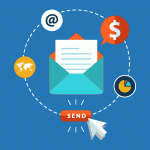Understanding the basics of email marketing
Email marketing is a powerful tool that businesses can use to connect with their audience and drive sales. It involves sending promotional messages to a targeted list of email subscribers who have opted-in to receive communications from your business. The goal of email marketing is to build relationships with your subscribers and encourage them to take action, whether that be making a purchase, signing up for a service, or attending an event. By focusing on building a strong foundation first, businesses can develop a comprehensive email marketing program designed to evolve with their business.
The benefits of email marketing are numerous. It is a cost-effective way to reach a large audience, deliver targeted messages, and build brand awareness. Email marketing can also help businesses nurture leads, promote products and services, and drive sales. Additionally, email marketing provides valuable data and insights that can be used to optimize future campaigns. Some of the most effective types of email marketing campaigns include welcome emails, promotional emails, newsletters, and event invitations. By leveraging these different types of campaigns, businesses can create a comprehensive email marketing strategy that engages their audience and drives results.
To get the most out of email marketing, it’s important to focus on best practices and continually optimize your campaigns. This includes incorporating video into your emails, implementing email marketing automation, creating high-quality content, paying special attention to performance reports, and focusing on customer experience and personalization. By following these best practices, businesses can create effective email marketing campaigns that engage their audience and drive results. The Ultimate Guide to Email Marketing provides a comprehensive framework for creating a successful email marketing strategy, from building a list to tracking results.
Ultimate Guide to Email Marketing: Creating an effective email marketing strategy
Creating an effective email marketing strategy requires careful planning and execution. The first step is to define the target audience for your emails. Identifying who your ideal customer is, their preferences, and their needs will help you tailor your messaging and content to resonate with them. Once you have a clear understanding of your target audience, you can begin setting campaign objectives and goals. These goals should be specific, measurable, attainable, realistic, and time-sensitive (SMART). By having clear objectives, you can measure the success of your campaigns and make data-driven decisions to improve future campaigns.
Crafting compelling email content is essential to the success of your email marketing campaigns. Your email content should be engaging, informative, and relevant to your target audience. To create effective email content, you should use a familiar from name, write a short and benefit-focused subject line, compelling preheader text, and simple and persuasive body content [10]. Additionally, you should consider the timing and frequency of your emails to ensure they are delivered at the right time and not overwhelming your subscribers.
To sum up, email marketing can be a powerful tool for businesses to connect with their target audience. By defining your target audience, setting clear campaign objectives, and crafting compelling email content, you can create effective email marketing campaigns that drive engagement and conversions. Remember to track your metrics and analyze your results to continuously improve your campaigns and achieve your marketing goals. With the right approach, email marketing can be a valuable addition to your overall marketing strategy.
Ultimate Guide to Email Marketing: Measuring and optimizing email marketing performance
To ensure the success of an email marketing campaign, it is essential to track and measure key metrics. This allows marketers to analyze and interpret the data, make data-driven improvements, and optimize future campaigns for better performance. Some of the key metrics to track include open rates, click-through rates, conversion rates, bounce rates, and unsubscribe rates. By monitoring these metrics, marketers can gain insights into their audience’s behavior, preferences, and engagement levels, which can inform their email marketing strategy.
Analyzing and interpreting data is a crucial step in optimizing email marketing campaigns. By examining the metrics, marketers can identify areas for improvement, such as subject lines, email content, or call-to-action buttons. They can also segment their audience based on their behavior and preferences, allowing for more personalized and targeted messaging. Additionally, analyzing data can help marketers identify trends and patterns, enabling them to make informed decisions about future campaigns.
Making data-driven improvements to email campaigns is essential for increasing their effectiveness. This involves using the insights gained from analyzing the data to make changes to the email content, design, or timing. It also involves testing different elements of the campaign, such as subject lines or calls-to-action, to determine what resonates best with the audience. By continually optimizing and improving email marketing campaigns based on data-driven insights, marketers can increase engagement, conversions, and overall ROI.
For more information on how https://www.dtriplers.com can help you with Ultimate Guide to Email Marketing, please contact us at (032) 233 6629, or visit us here:
Dtriplers Internet Marketing Solutions
Cebu Customs Road, Apas, Cebu City, 6000 Cebu








